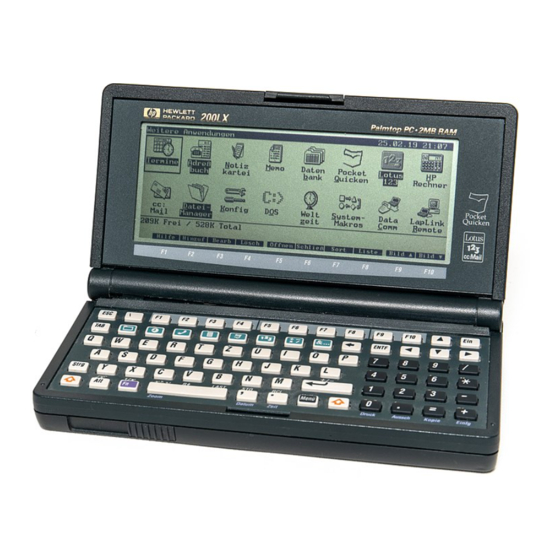
HP 200LX Palmtop PC Manuals
Manuals and User Guides for HP 200LX Palmtop PC. We have 1 HP 200LX Palmtop PC manual available for free PDF download: User Manual
HP 200LX User Manual (471 pages)
Palmtop PC
Table of Contents
-
Contents6
-
Product View18
-
Saving Data23
-
Terminology23
-
Menus30
-
About 1-2-350
-
To-Do Lists70
-
SSL Syntax104
-
SSL Examples107
-
World Time111
-
City Lists111
-
Using the Map116
-
The Stopwatch122
-
The Memo Editor124
-
Creating a Memo125
-
Editing a Memo125
-
Printing a Memo138
-
The Note Taker142
-
Creating a Note143
-
To Delete a Note145
-
Pocket Quicken150
-
What's a Group?156
-
Disk Space169
-
Solving Problems173
-
Percent187
-
Using Registers191
-
The TVM Screen204
-
Loans with Fees223
-
Plotting236
-
Statistics241
-
Entering Guesses262
-
Constants264
-
Functions264
-
Solver Functions265
-
Date Formats265
-
Discounted Notes278
-
Moving Average279
-
To Draw a Graph286
-
To Zoom in286
-
To Zoom out287
-
DOS System RAM304
-
File List View314
-
System Macros325
-
Types of Memory335
-
Cic100/Gen 1345
-
Fdisk100345
-
Dispctl346
-
Serctl346
-
Keybez346
-
KIT File Format350
-
To Load a TSR352
-
Datacomm358
-
Hangup366
-
Printing380
-
CC:mail384
-
Batch Transfer385
-
About Folders388
-
To Delete a Host399
-
Backslash400
-
Circumflex400
-
Character Set415
-
Running KEYBEZ420
-
Games433
-
Index434
Advertisement
Advertisement
